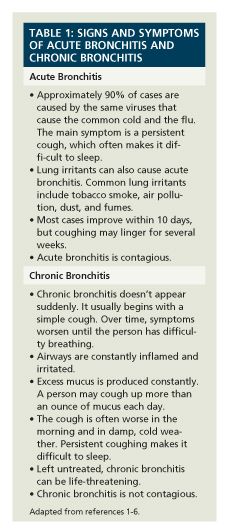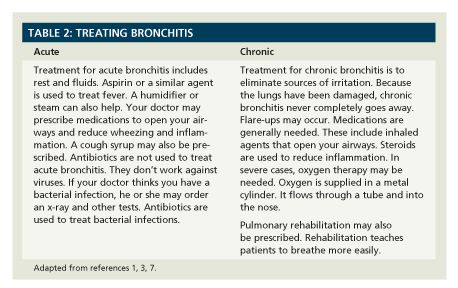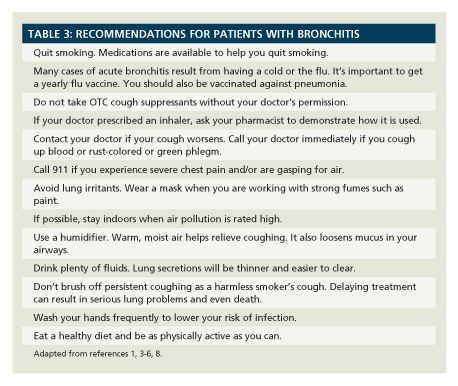Article
Beating Bronchitis
Author(s):
Steps can be taken to prevent bronchitis from becoming a chronic condition.
Steps can be taken to prevent bronchitis from becoming a chronic condition.
What Is Bronchitis?

Bronchitis is a condition in which the bronchial tubes are inflamed. These tubes carry air to the lungs. When the tubes become inflamed or infected, they produce a lot of mucus. Mucus is a slimy substance that is made by the bronchial tubes. Bronchitis’s main symptom is persistent coughing. Coughing is the body’s attempt to get rid of excess mucus. Forceful coughing can be painful. Excess mucus also makes it difficult to breathe. Other bronchitis symptoms include a low-grade fever, shortness of breath, and wheezing. Wheezing is a whistling or squeaky sound when you breathe.
There are 2 types of bronchitis: acute (short-term) and chronic (long-term). In both types, irritated membranes swell and grow thicker. This swelling shuts off the tiny airways in the lungs. Acute bronchitis is often the result of infections or exposure to irritants. Cigarette smoking is the main cause of chronic bronchitis. Chronic bronchitis is sometimes called a “smoker’s cough” (Table 1).
A single acute episode is not a cause for concern. Repeated episodes may lead to chronic bronchitis. A person with chronic bronchitis has scarred lungs. This scarring cannot be reversed. Lung damage makes it difficult to breath. Damaged lungs also increase the risk for infections. Elderly and those with weakened immune systems have the greatest risk for developing bronchitis.1,5,6
How Is Bronchitis Treated?
The main treatment goal is to relieve symptoms. Along with standard treatment (Table 2), some patients use natural and home remedies. Certain foods seem to reduce symptoms. These include honey, lemon, ginger, bay leaf, and almonds. Patients should discuss natural remedies with their doctor before using them.4

Can I Do Anything to Lessen My Symptoms?
Chronic bronchitis can be prevented by not smoking. Patients should avoid secondhand smoke and other lung irritants. Table 3 highlights other recommendations. People with shortness of breath should breathe using the technique of pursed-lip breathing. Pursed-lip breathing helps reduce shortness of breath. These are the 5 steps for pursed-lip breathing:
- Relax the muscles in your neck and shoulders. Sit in a comfortable chair with your feet on the floor.
- Breathe in (inhale) slowly through your nose for 2 counts.
- Feel your belly get larger as you breathe in.
- Pucker your lips as if you were going to whistle or blow out a candle.
- Breathe out (exhale) slowly through your lips for 4 or more counts.
Be sure to exhale normally. Do not force air out. Do not hold your breath when you are doing pursed-lip breathing. Repeat these steps until your breathing improves.9
Where Can I Find More Information?
The American Lung Association (www.lung.org) provides useful and easy-to-understand information on bronchitis.

Dr. Zanni is a psychologist and health-systems consultant based in Alexandria, Virginia.
References
- National Heart, Lung, and Blood Institute. What is bronchitis? www.nhlbi.nih.gov/health/health-topics/topics/brnchi. Accessed September 9, 2013.
- Centers for Disease Control and Prevention. Chronic obstructive pulmonary disease. www.cdc.gov/copd. Accessed October 15, 2013.
- Mayo Clinic staff. Bronchitis. www.mayoclinic.com/health/bronchitis/DS00031. Accessed September 9, 2013.
- Cunha J. Bronchitis causes, symptoms, home remedies, medical treatment. www.emedicinehealth.com/bronchitis/article_em.htm. Accessed September 12, 2013.
- WebMD. Understanding bronchitis: the basics. www.webmd.com/lung/understanding-bronchitis-basics. Accessed September 12, 2013.
- American Lung Association. Understanding chronic bronchitis. www.lung.org/lung-disease/bronchitis-chronic/understanding-chronic-bronchitis.html. Accessed September 9, 2013.
- United States National Library of Medicine, MedlinePlus. Chronic bronchitis. www.nlm.nih.gov/medlineplus/chronicbronchitis.html. Accessed September 9, 2013.
- United States National Library of Medicine, MedlinePlus. Acute bronchitis. www.nlm.nih.gov/medlineplus/acutebronchitis.html Accessed September 9, 2013.
- United States National Library of Medicine, MedlinePlus. How to breathe when you are short of breath. www.nlm.nih.gov/medlineplus/ency/patientinstructions/000053.htm. Accessed September 9, 2013.
Newsletter
Stay informed on drug updates, treatment guidelines, and pharmacy practice trends—subscribe to Pharmacy Times for weekly clinical insights.





